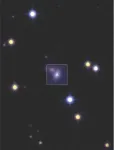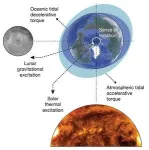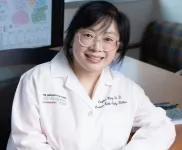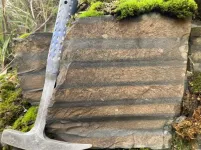Astronomers discover supernova explosion through rare ‘cosmic magnifying glasses’
Researchers gain insight into how the universe is expanding thanks to gravitational lensing, a natural phenomenon that warps space around galaxies and visually magnifies celestial objects.
2023-06-12
(Press-News.org) According to Einstein’s general theory of relativity, time and space are fused together in a quantity known as spacetime. The theory suggests that massive objects, like a galaxy or galaxy clusters, can cause spacetime to curve. Gravitational lensing is a rare yet observable example of Einstein’s theory in action; the mass of a large celestial body can significantly bend light as it travels through spacetime, much like a magnifying lens. When light from a more distant light source passes by this lens, scientists can use the resulting visual distortions to view objects that would otherwise be too far away and too faint to be seen.
An international team of scientists, including University of Maryland astronomer Igor Andreoni, recently discovered an exceptionally rare gravitationally lensed supernova, which the team named “SN Zwicky.” Located more than 4 billion light years away, the supernova was magnified nearly 25 times by a foreground galaxy acting as a lens. The discovery presents a unique opportunity for astronomers to learn more about the inner cores of galaxies, dark matter and the mechanics behind universe expansion. The researchers published their findings—including a comprehensive analysis, spectroscopic data and imaging of SN Zwicky—in the journal Nature Astronomy on June 12, 2023.
“The discovery of SN Zwicky not only showcases the remarkable capabilities of modern astronomical instruments but also represents a significant step forward in our quest to understand the fundamental forces shaping our universe,” said the paper’s lead author Ariel Goobar, who is also the director of the Oskar Klein Center at Stockholm University.
Initially detected at the Zwicky Transient Facility (ZTF), SN Zwicky was quickly flagged as an object of interest due to its unusual brightness. Then, using adaptive optics instruments on the W.M. Keck Observatory, the Very Large Telescopes and NASA’s Hubble Space Telescope, the team observed four images of SN Zwicky taken from different positions in the sky and confirmed that gravitational lensing was behind the supernova’s extraordinary radiance.
According to Andreoni, who is a postdoctoral associate in UMD’s Department of Astronomy and NASA’s Goddard Space Flight Center, supernovae like SN Zwicky play a crucial role in helping scientists measure cosmic distances.
“SN Zwicky not only is magnified by the gravitational lense, but it also belongs to a class of supernovae that we call ‘standard candles’ because we can use their well-known luminosities to determine distance in space,” Andreoni explained. “When a source of light is farther away, the light is dimmer—just like seeing candles in a dark room. We can compare two light sources in this way and gain an independent measure of distance without having to actually study the galaxy itself.”
In addition to being useful as a metric for cosmic distance, SN Zwicky also opens new avenues of research for scientists exploring the properties of galaxies, including dark matter (which is matter that does not absorb, reflect or emit light but make up the majority of matter in the universe). Researchers also believe that lensed supernovae like SN Zwicky could prove to be very promising tools for examining dark energy (a mysterious force counteracting gravity and drives the accelerated expansion of the universe) and refining current models describing the universe’s expansion, including the calculation of the Hubble constant—a value that describes how fast the universe is expanding.
For Andreoni, who is preparing for the opening of the Vera Rubin Observatory in Chile, the team’s success in identifying and analyzing SN Zwicky is only the beginning. Now still in its construction phase, the new observatory is expected to begin full operations in 2024 and build upon the team’s findings as it takes multiple images of the entire visible sky to search for other supernovae and asteroids. Andreoni believes that the “big picture” tactic used to find SN Zwicky will continue to help scientists gather large volumes of data about celestial events in the sky.
“This discovery paves the way to find more of such rare lensed supernovae in future big surveys that will help us study transient astronomical events like supernovae and gamma ray bursts,” Andreoni said. “We look forward to more unexpected discoveries using broad, untargeted optical surveys of the sky like the one that helped us identify SN Zwicky. With this approach, we’ll be able to probe the transient sky with an unprecedented depth.”
###
This article was partially adapted from text provided by the Oskar Klein Center at Stockholm University.
The research was supported by the National Science Foundation (Grant Nos. AST-2034437 and 1106171), the Knut and Alice Wallenberg Foundation (under Dnr KAW 2018.0067 and research project grant “Understanding the Dynamic Universe”), the Swedish Research Council (Project No. 2016-06012, and Contract Nos. 2020-03444 and 2020-03384), the European Research Council (Grant No. 759194-USNAC), the European Organization for Astronomical Research in the Southern Hemisphere, and the United Kingdom Science and Technology Facilities Council. This story does not necessarily reflect the views of these organizations.
The paper, “Uncovering a population of gravitational lens galaxies with magnified standard candle SN Zwicky," was published on June 12, 2023 in Nature Astronomy.
END
[Attachments] See images for this press release:


ELSE PRESS RELEASES FROM THIS DATE:
2023-06-12
HOUSTON – A new study by researchers at The University of Texas MD Anderson Cancer Center highlights novel insights into the evolution of multiple myeloma from precursor disease, which may help better identify patients likely to progress and develop new interventions.
Published today in Cancer Cell, the study integrates paired single-cell RNA sequencing and B cell receptor sequencing from 64 patients with multiple myeloma or precursor disease. The study achieved several notable milestones in the effort to better understand ...
2023-06-12
A new material, created at the little-explored intersection of organic and inorganic chemistry, could not only enable more powerful solar panels, but it could also usher in the next generation of cancer treatments.
Described in a Nature Chemistry journal paper published today, the composite is made of ultra-tiny silicon nanoparticles, and an organic element closely related to those used in OLED televisions. It is capable of increasing the speed with which two molecules can exchange energy, and of converting lower-energy light into higher-energy light.
Only a handful of laboratories ...
2023-06-12
It's tough accomplishing everything we want to get done in a day. But it would have been even more difficult had we lived earlier in Earth's history.
Although we take the 24-hour day for granted, in Earth's deep past, days were even shorter.
Day length was shorter because the Moon was closer. "Over time, the Moon has stolen Earth's rotational energy to boost it into a higher orbit farther from Earth," said Ross Mitchell, geophysicist at the Institute of Geology and Geophysics of the Chinese Academy of Sciences and lead author of a new study published in Nature Geoscience.
"Most models of Earth's rotation predict that day length was consistently shorter ...
2023-06-12
Researchers at Karolinska Institutet have created a new method of studying the smallest bioparticles in the body. The study, which is published in Nature Biotechnology, has considerable scientific potential, such as in the development of more effective vaccines.
Circulating around the body are nanoparticles that affect it in one way or another. For example, there are lipoproteins that maintain cell metabolism, pathogenic viruses that cause many diseases and lipid nanoparticles that are used to carry drugs, like recent lipid nanoparticle-based mRNA vaccines.
However, ...
2023-06-12
In a study published in Nature Astronomy today, a team of researchers from the University of Naples “Federico II”, the University of Wroclaw, and the University of Bergen examined a quantum-gravity model of particle propagation in which the speed of ultrarelativistic particles decreases with rising energy. This effect is expected to be extremely small, proportional to the ratio between particle energy and the Planck scale, but when observing very distant astrophysical sources, it can accumulate to observable levels. The ...
2023-06-12
FAIRFIELD, NJ—Parker Laboratories Inc. has announced that the environmental protection and pesticide control agencies of all 50 states have authorized registration of Tristel DUO, an intermediate-level disinfecting foam for the cleaning and disinfection of general medical surfaces—including noninvasive ultrasound transducers and their related equipment.
Tristel DUO is manufactured and distributed for US markets by Parker Laboratories under an exclusive commercial partnership with UK-based infection prevention company Tristel plc. Parker Laboratories ...
2023-06-12
DALLAS, June 12, 2023 — The American Heart Association, the world’s leading voluntary organization focused on heart and brain health, invites scientific researchers across the globe to compete in a new data challenge to better inform the scientific understanding of how lipoprotein(a) [Lp(a)] levels impact the risk of cardiovascular disease and stroke. The winning project is eligible to receive a $40,000 USD cash prize.
High levels of Lp(a) — a low-density lipoprotein variant containing a protein called apolipoprotein(a) ...
2023-06-12
(Toronto, June 12, 2023) – New research published in JMIR Cardio reveals the remarkable potential of artificial intelligence (AI) technology in analyzing coronary angiography, a common diagnostic procedure for coronary artery disease. Led by Dr In Tae Moon, the study conducted at Uijeongbu Eulji University Hospital in Korea showcases the power of AI-based quantitative coronary angiography (AI-QCA) in enhancing clinical decision-making.
The study compared AI-QCA to intravascular ultrasound (IVUS), to validate its performance. IVUS is ...
2023-06-12
JMIR Bioinformatics and Biotechnology (JBB) is a leading, international, peer-reviewed journal that aims to publish high-quality original research articles, reviews, and perspectives on all aspects of bioinformatics, computational biology, and biotechnology.
We invite researchers, educators, and practitioners to submit their original research articles, reviews, and perspectives to JBB. Our scope includes but is not limited to:
Bioinformatics, including genomic variation detection algorithms, tools, and databases
Artificial ...
2023-06-12
“It is an honor,” Smith said. “The ASME Turbo Expo community has been a valuable part of my professional development and it has been a pleasure to give back." Since joining SwRI in 2016, Smith has performed aerodynamic design and testing of turbomachinery and advanced system analysis for programs related to power generation, aviation, oil and gas, and energy storage, including next-generation supercritical carbon dioxide power cycles.
Smith has also managed three long-duration energy storage projects, developing a pumped thermal energy storage (PTES) demonstration facility, conducting a techno-economic feasibility study of ...
LAST 30 PRESS RELEASES:
[Press-News.org] Astronomers discover supernova explosion through rare ‘cosmic magnifying glasses’
Researchers gain insight into how the universe is expanding thanks to gravitational lensing, a natural phenomenon that warps space around galaxies and visually magnifies celestial objects.









